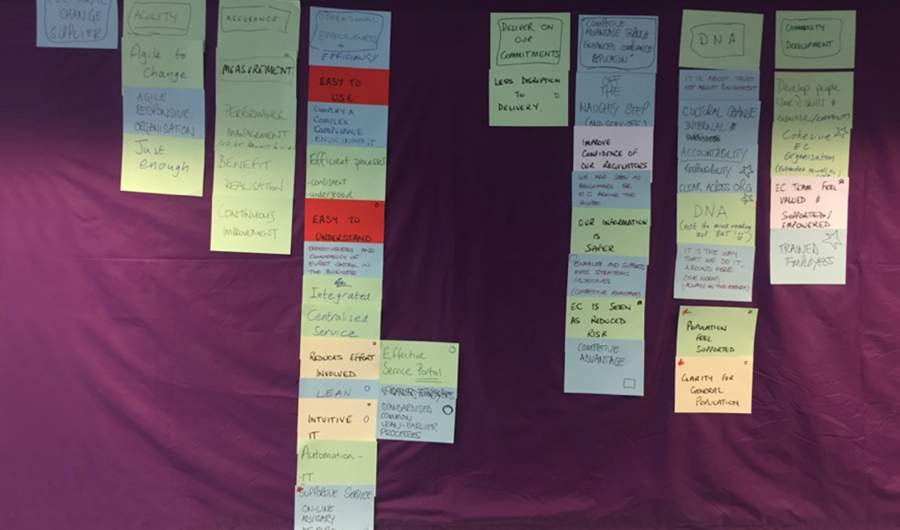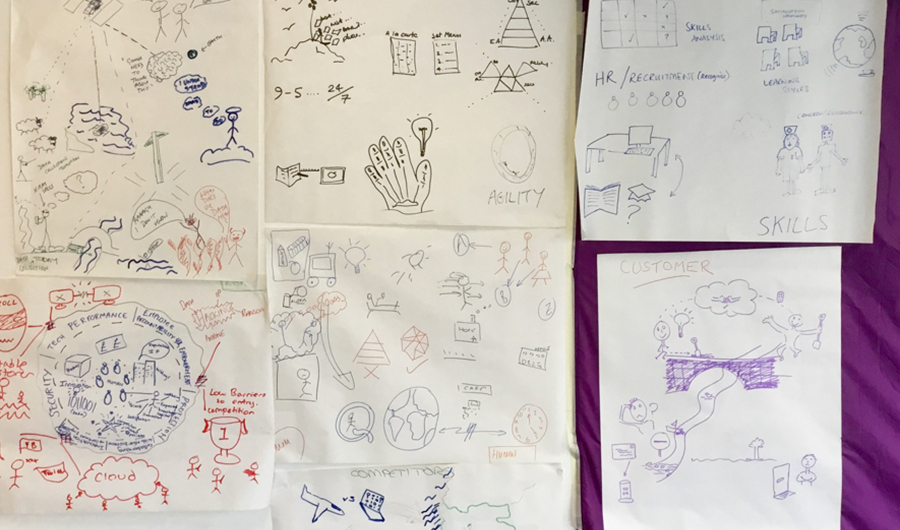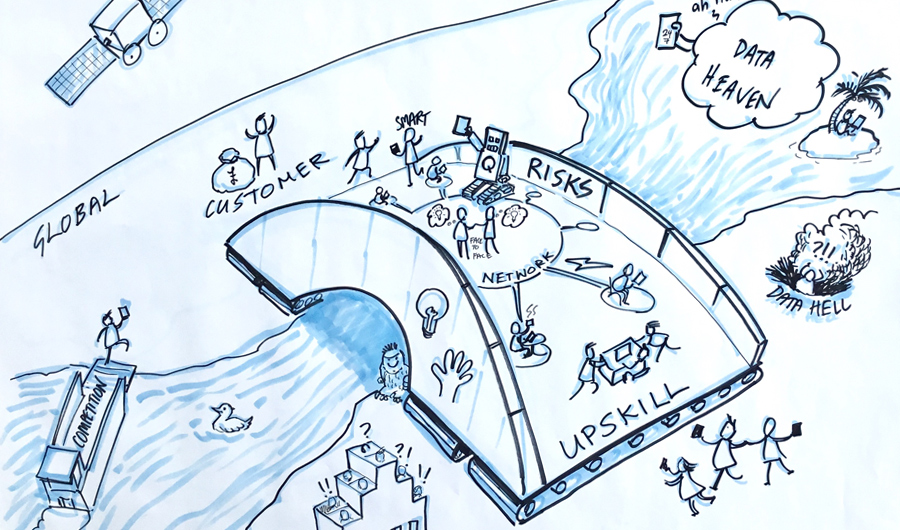Use visual thinking to transform your business and employee communications
By
— September 13th, 2018

The importance of clear direction
In today’s business environment rapid change is critical for survival. Digital transformation is reshaping supply chains, changing commercial relationships, and enabling smarter ways to work from home, on the go, and with virtual teams.
Disruptors change the competitive landscape and empowered customers demand different and more personalized service.
Creating agility to respond to these changes needs empowered teams able to make quick decision’s and operate with autonomy. But this, in turn, depends upon teams and team members clear about the purpose of their business and understanding the vision and strategy.
People need these to prioritize, focus and make decisions. That is how strategy gets delivered – by people making the right decisions, thousands of times, every day, in numerous locations.
How do you equip people with the knowledge and understanding of these things to inform these decisions? And how do you do so in a way that is itself flexible and agile so that as situations change, so do local responses and action plans?
Agility and responsiveness depend upon the willingness to connect and collaborate in new ways, to focus on shared goals with colleagues and partners and perhaps most fundamentally to:
- Understand the bigger picture – the purpose, vision, values, and strategy
- “Buy into” it – feel that the bigger picture is meaningful and relevant, and worth it
- Build line of sight to translate that bigger picture into local actions
Brain-friendly approaches to change
Since it is brains that do the thinking and deciding, insights from neuroscience are important. We know that:
- Visual processing takes up about half of everything that our brain does
- We are driven by emotions as much as reason
- We avoid threats and move towards things our brains interpret as rewards
- When not threatened we are more creative, collaborative, open, innovative and effective
- This state of mind requires increases in feelings of autonomy, purpose, good relationships, self-esteem, certainty and fairness
Sources: for more information on the implications of recent Neuroscience research for how we communicate see John Medina, Brain Rules and Hilary Scarlett, Neuroscience for Organisational Change.
The rapid growth of visual communication and storytelling is no coincidence. These are brain-friendly ways to communicate that are appealing, catch our attention, trigger emotions, can help us understand, and are more memorable.
Look at this recent video from Airbus with Matthew Evans explaining the Skywise initiative to see how visuals and narrative help to convey the bigger picture. Or this visual narrative from Oxfam to provide a platform for the organization’s story.
But capturing the bigger picture is only half the job. The challenge is to use the bigger picture to help inform local actions.
The most effective way to ensure people “get it” is not to talk at them but to listen and lead conversations at the local level. It requires team leaders and colleagues who can help people make sense of what to do in the context of the situation they face on a day to day basis.
The power of visual thinking
In developing the big picture, visual thinking can help leaders generate powerful narratives and insights. Visual thinking does not just mean “pictures.” It includes cards with clear ideas on display to help individuals and groups sort and prioritize, creating patterns in data to see linkages and themes, and exploring concepts and ideas using simple drawings.
For example, every business is grappling to understand how technology will affect operations in the next 5 – 10 years. A group of leaders wrote their own short answers and then worked in pairs across companies to summarise on a card their key ideas. By putting these in front of the wider group, they began to discern themes and patterns in over 50 different ideas.

These revolved around how peoples’ roles and skills will change, how business needs to become more agile, how markets are changing, how customers’ expectations are changing, how risk management is becoming more complex and how big data will transform decision making.
Then by asking executives to draw the impact on their businesses they began to identify thorny and shared challenges. Even although the individuals had not met before the day, they found visualizing the challenges and using their pictures to debate them, helped them open up and generate insights quickly.

For example, the leaders talked about how they could:
- Support “always on” working patterns
- Liberate people to respond instantly
- Transform service design and operation
- Identify and build new skills
- Define and mitigate new risks caused by over-reliance on technology
- Identify and respond to new competitive challenges
A final visual helped to capture the conversation to provide a platform for each business to lead conversations around the challenges back in their own operations.

Visual thinking throws up vivid and insightful challenges that change leaders need to manage. A picture provides a platform for a conversation, and it is conversations that lead to change.
Leading the conversation
The communication skills of team leaders set the climate for these conversations. The communication team can support by:
- Giving leaders tools, knowledge and questions to help them lead effective conversations
- Reminding them of what’s helpful to people (back to neuroscience):
- Clear, short-term goals in context that builds more purpose and certainty
- Praise, recognition, and celebration of successes for self-esteem
- Transparency of decision-making for fairness and trust
- Listening, openness, personal attention, and vulnerability to build relationships
- Direction, conversation, and agreement on priorities, but space for delivery to make people feel they are in control and making the key decisions
For example, visual thinking and big pictures have been used by:
- Companies such as BAE Systems, Vodafone, GSK, Pfizer, and TUI
- Public and third sector organizations such as the British Home Office, Cabinet Office, Department for Transport and Oxfam
However, what really matters is that visuals, videos, and narratives are used as the start point for great conversations. Local managers do this by prompting people with questions. Positively phrased questions are non-threatening and more likely to create co-operative working and collaboration. For example:
- How would we benefit if the business achieved its vision?
- How can we change the way we work together to move us towards the vision?
- What are our stories of success and what can we learn from them?
- What do our customers really value about our support, and how can we help them even more?
- When we’re great what do we do, and how can we do more of it?
- How do we make sure personal goals and objectives support our collective aims?
Positively phrasing questions does not mean that groups should not discuss problems nor that skeptics and challenges should not be heard.
The point is that starting with an emphasis on strengths and encouraging conversations around goals and objectives is more likely to create a climate that is supportive and one that will move the organization in the direction it wants to go. David Cooperrider’s Appreciative Inquiry approach is based on this perspective.
Visual thinking in action
Visual thinking can help leaders, managers, team leaders, and front-line people have the right conversations they need to, day after day.
As well as being appealing and memorable, visual thinking creates platforms for conversation and involvement. These conversations on the frontline and in the back offices need to:
- Encourage people to think for themselves
- Evolve priorities and plans
- Link these to the higher purpose of the organization.
The more images portray other people the more engaging and memorable they will be (another insight from neuroscience research).
Tools for the delivery (i.e. the things that are used to have the conversations around) might include big pictures, organizational narratives, videos, customer journeys, and leaders’ own stories.
They may be delivered in town halls, team workshops, leadership messaging/presentations/articles, conferences, campaigns, and normally a combination of these. But the important thing is to use these approaches as a platform for conversation, not as a broadcast.
We need this more than ever as we navigate increasingly tough competitive landscapes and rapidly changing organizations. Visuals and great conversations help ensure engagement and support local change. Below is a visual summary of this article to capture the key points:
Using visual communication for purpose, meaning, and vision
ⒸCouravel www.couravel.com +44 (0) 1732 371 252








